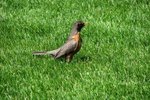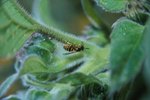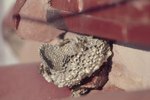
Telling the sex of a bee is a pretty simple matter: If it's doing typical bee things, such as visiting flowers or working in a hive, it's female. If it's chasing a queen, dead on the ground or dying in the snow, it's male. The pulse of hive life is exclusively female and there's very little room for males outside of a single event in each queen's life.
Society of Maidens
Bees, ants and wasps are members of order Hymenoptera, named for a word -- and an ancient Greek god -- related to female virginity. Almost all hymenopteran species are social. Societies cluster around queens -- single reproductive females who are the biological mothers of their entire hives, which can number hundreds of thousands. A mated queen first raises a batch of workers, then spends the rest of her life laying eggs full-time while workers raise young and do all the building, food collection and defense. All of the workers come from fertilized eggs. On rare occasions she lays unfertilized, haploid eggs. These hatch into males, called drones.
Bachelor Life
Besides the obvious, drones are physically distinct from females. Their only job is to locate new queens, and they have enhanced sensory apparatus to help them. Their joined eyes are much larger than workers', and their antennae have additional segments, which may aid in chemically sensing their quarry. They're also larger than workers, stingless, and in some species have blacker bodies. Once pupated, they fly to drone congregation areas -- places where drones from multiple hives gather year after year to wait for new queens to fly past. When they're exhausted from all this flying and waiting, they return to the hive and workers feed them.
One Thing and One Thing Only
Males are few because they perform only one task -- inseminating new queens -- and do this only once. As established queens grow old, die or prepare to leave their hives, workers produce new queens from female larvae -- in some hives they do this all along, but the original queen kills the potential rivals until she dies or becomes so feeble she can't, or until the hive is so large it must split up. After a new queen successfully pupates, she leaves on her nuptial flight through the drone congregation areas. Males from every hive within about 2 miles swarm together and chase her. The first to reach her -- up to several dozen -- mate. This single encounter provides all the sperm she'll use for the rest of her life.
Just Can't Win
Mated males have only a brief moment to glory in their evolutionary success -- they drop dead before they hit the ground. But lest they notice this trend and get any ideas, avoiding the ladies altogether won't save them from their tragic fate. Biologically incapable of providing any further benefit to their hives and unable to feed themselves, non-mated males who survive until the beginning of harsh weather -- winter in cold areas, drought in hot ones -- are killed outright or driven out by the workers to die.
References
Photo Credits
-
Photos.com/Photos.com/Getty Images
Writer Bio
Angela Libal began writing professionally in 2005. She has published several books, specializing in zoology and animal husbandry. Libal holds a degree in behavioral science: animal science from Moorpark College, a Bachelor of Arts from Sarah Lawrence College and is a graduate student in cryptozoology.



